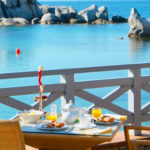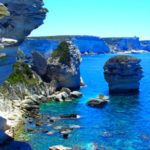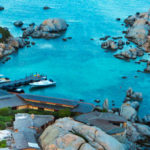“In the Heart of the City of the Lily”
A collaborator of IsHotel, Costanza Barlondi is a tourist guide in her hometown of Firenze. Together with Emiliano Cribari, she skilfully and meticulously researches the most picturesque and less known parts of the city. An exciting interdisciplinary journey that offers a novel viewpoint on the city that never stops surprising you.
Hi Costanza, if we had to meet in Florence, what place would you choose?
The Chiostro dello Scalzo, a wonderful cloister housing 16th-century frescoes by Andrea del Sarto, and often unknown to Florentines themselves. I’d choose it for two reasons. First, because it is a peaceful and beautiful oasis in the midst of the city centre; and second, because people often forget that Florence offers way more than just the Galleria degli Uffizi and David di Michelangelo There’s so much more to discover: hidden art treasures, culinary traditions, local handicrafts…
Several cities in the world are nicknamed “The Magic City”. How magic is your hometown of Florence, and why?
Florence is a magic place to me because, even though I’ve always lived here, there are so many things that keep surprising me, such as the light at sunset, something in the window of an artisan workshop, or finding some new detail in a work of art that I have seen many times… And I find myself taking photos, like a tourist (but I will never join the selfie stick craze!)

I think that one of the best things about art history is that it is an interdisciplinary subject. By studying the Medici collections, for instance, I have found myself learning about porcelain manufacturing techniques, the invention of the piano, cartography and the systems of measurement used at the time, the history of the great European dynasties … Subjects that at first sight may seem unrelated, but which come together like the pieces of a giant jigsaw puzzle whose scope extends from Florence to the rest of the world – and which I will probably never complete. But after all, the fun is over once the puzzle is complete, right?
Florence is synonym with “Uffizi”, a very popular destination for mass tourism and, no wonder, one which is often overbooked. Despite having been associated with “slow tourism”, our sector, too, runs the risks of becoming an object of touristic consumerism. Do you feel you are part of the solution to this problem?
I believe that being a tourist guide means, among other things, being an ambassador of your city. The guide is often one of the few local people with whom tourists interact, so I feel the responsibility to represent my hometown in the best possible way and, as an expert on Florence, to guide visitors through places that do not feature on standard itineraries but embody the essence of the city.
We are well acquainted with Emiliano and the “objective” he pursues. What the two of you offer is more than just an educational approach. How would you describe the experience of touring Florence with the two of you?
We think that the added value we bring to this tour lies in the fact that Emiliano and I are both Florentines who love Florence. We aim to show our customers some of the lesser-known corners of the city, to reveal to them the secrets buried in the walls of Florence’s churches and palaces, and to help them discover the workshops where artisans still create the excellent products that have made Florence famous all over the world, including leatherwork, marbled paper, and perfumes.
How many days do you recommend to spend in Florence in order to really understand it, or at least to get a correct impression of the city as a whole?
I have noticed that tourists often stay for just a couple of days, or even 24 hours. Considering that over ten per cent of the Italian cultural heritage is located in this city, I would recommend at least five days, not only in order to admire the artistic beauties of Florence, but also to try and understand the personality of its inhabitants: like the old palaces, they may appear to have a stern, rough façade but, if you try to go beyond first impressions, will reveal their cheerfulness and their proud love for their hometown.
The City of the Lily is famous also for its surroundings and its villas…
I always recommend visiting the villas in the countryside: it is a great way to leave the hustle and bustle of the city and, for instance, discover the 150 varieties of citrus fruits in the garden of the Villa di Castello or the magnificent furnishings of the Villa La Petraia, commissioned all over Italy by king Vittorio Emanuele II for his Rosina…
And what about our Villa Tolomei?
Villa Tolomei is a unique place located at walking distance from the city centre but, at the same time, immersed in the quiet of the Tuscan countryside. Its wonderful frescoed interiors have the charm befitting an historic residence, but at the same time the hotel is equipped with every comfort, from a swimming pool to a restaurant that can satisfy even very demanding customers.
Recent years have seen an increase in the number of culinary tours and gastronomic itineraries, and the idea of food seems more and more connected to the notions of exploration and territory. How does this impact on your work?
I don’t think you can fully understand the culture and traditions of a territory unless you experience the local cuisine. This is even more true for Florence and Tuscany, where vines and olive trees have been cultivated since Etruscan times. For this reason, I always propose to my customers itineraries in the Tuscan countryside which combine the beauty of the landscape and tastings of olive oil, wine, cheese and cold cuts. I like to choose small producers who still use traditional systems and are the custodians of an artisan tradition that represents one of the main assets of this region.
Like other cities, Florence deserves to be visited at least once in a lifetime. What would you tell a tourist to convince them to come again?
I have never had to convince anybody: most of the time, it is my customers who, at the end of a tour, come and say to me, “See you soon! We definitely want to come back and discover more things!
Finally, what would you like to say to the current and future guests of Villa Tolomei?
You have chosen a wonderful hotel. I look forward to showing you the best of the city and surrounding areas, in the hope to make your stay even more special!







